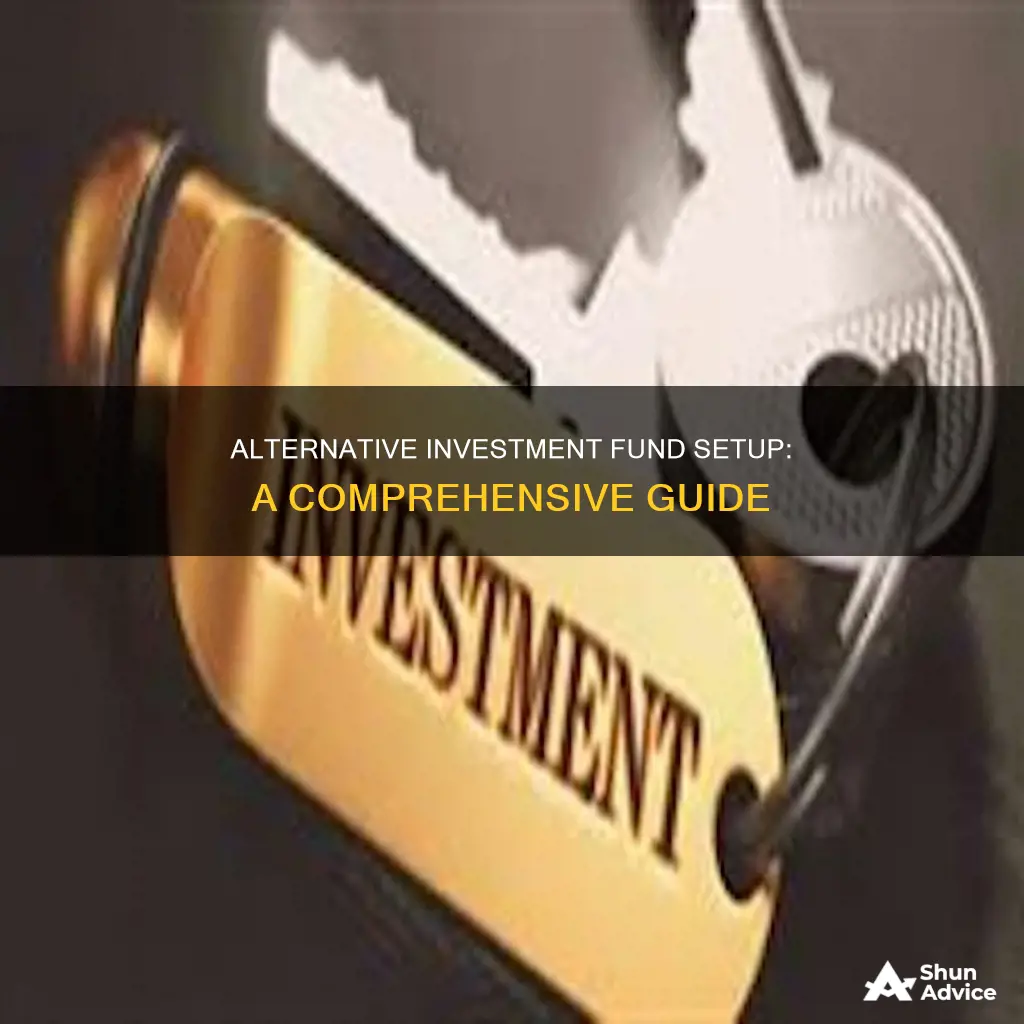
Alternative Investment Funds (AIFs) are a special category of investment that differs from conventional investment instruments like stocks, bonds, and cash. AIFs are privately pooled investment vehicles that collect funds from investors and invest in non-traditional asset classes, such as real estate, commodities, hedge funds, private equity, and venture capital. These funds are typically targeted at high-net-worth individuals, institutions, and family offices due to their complex nature, higher risk, and substantial investment amounts required.
Setting up an AIF involves several key steps, including defining an investment strategy, establishing a legal entity, registering with the relevant regulatory body, ensuring compliance, and attracting investors. AIFs can be structured as a company, trust, or limited liability partnership, and it's important to engage external stakeholders, such as legal and tax advisors, to navigate the regulatory landscape.
| Characteristics | Values |
|---|---|
| First step | Select the right fund domicile for your fund |
| Second step | Establish a suitable fund structure |
| Third step | Attract investors to your fund |
| Fourth step | Stay compliant with EU regulations |
What You'll Learn

Select the right fund domicile
The first step in establishing an alternative investment fund in Europe is to select the right fund domicile for your fund. This involves identifying a suitable jurisdiction that aligns with your specific goals and objectives. Popular locations for fund domiciles include Ireland, Luxembourg, Jersey, Guernsey, and the UK. It is important to note that the decision on the fund domicile will depend on various factors and may vary greatly depending on your specific objectives.
To make an informed decision, it is advisable to seek guidance from a jurisdiction-agnostic adviser who operates in multiple domiciles. These advisers have a comprehensive understanding of the types of clients who succeed in each region and can provide unbiased recommendations as they do not have a vested interest in the jurisdiction you ultimately choose. Their expertise can be invaluable in navigating the complexities of different regulatory and tax environments across jurisdictions.
Additionally, engaging external stakeholders, such as a funds partner, regulatory council, and tax advisors, can provide valuable legal and regulatory insights. Their experience in the relevant jurisdictions will enable them to offer necessary guidance and support throughout the process of setting up your alternative investment fund.
Maximizing Your Roth IRA Returns with Index Funds
You may want to see also

Establish a suitable fund structure
Establishing a suitable fund structure is a critical step in setting up an alternative investment fund. Here are some detailed instructions and considerations for this process:
Firstly, avoid simply copying a structure that has worked for other fund managers. The structure of your fund should be tailored to your specific situation and strategy. Consult local fund lawyers and tax advisors to determine the most appropriate structure for your fund. Remember that European funds typically need to operate alongside a Cayman or Delaware structure, so ensure you understand the operational and structural implications of this.
When establishing your fund structure, ensure compliance with all applicable regulations. Different jurisdictions have varying regulatory requirements, so it is important to engage professionals with experience in the relevant jurisdictions. This will help you navigate the complex regulatory landscape and avoid any legal issues.
Additionally, consider the specific needs and preferences of your investors. Fundraising involves external partnerships that will last for the life of the fund, so choose your partners wisely. Conduct proper due diligence and ensure that all parties involved understand your strategy.
Furthermore, involve relevant internal stakeholders such as individuals from the investor relations team, legal team, fund operations team, and tax counsel. Clearly define the roles and responsibilities of each stakeholder to ensure a smooth setup process.
By following these instructions and considerations, you can establish a suitable fund structure that complies with regulations, meets the needs of your investors, and aligns with your fund's strategy.
Mutual Fund Strategies: Long-Term Investments for Financial Freedom
You may want to see also

Attract investors
Once you have established your fund structure and are satisfied with your compliance and regulatory setup, you can begin to attract investors. Alternative Investment Funds (AIFs) are not meant for the general public or retail investors, as they involve high risks, high costs, and low liquidity. They are suitable for high-net-worth investors who have the knowledge, experience, and financial capacity to invest in them.
When attracting investors, it is important to understand the specific needs and preferences of the investors who will be investing in the fund. It is also crucial to ensure that you are complying with applicable regulations in each jurisdiction. For example, the European regulatory landscape is complex and constantly changing, so it is important to be aware of how European rules are implemented within each country.
Investors in AIFs typically include high-net-worth individuals, institutions, and family offices. These investors are often seeking opportunities for capital appreciation and exposure to non-traditional asset classes. AIFs can offer high-return potential, low volatility options, and diversified investment avenues.
It is important to note that AIFs involve high risks, high costs, and limited liquidity. Therefore, investors should conduct thorough research and seek advice from qualified professionals before investing. Due diligence is crucial for investors considering alternative investments.
When attracting investors, it is essential to have a clear investment strategy and target audience in mind. This will help potential investors understand the fund's objectives and whether it aligns with their investment goals and risk tolerance.
Additionally, it is beneficial to have a strong marketing and communication strategy to reach potential investors and showcase the benefits and value of investing in your fund.
Unlocking Tax Benefits: Opportunity Zone Funds ETF
You may want to see also

Comply with EU regulations
Complying with EU regulations is a crucial aspect of setting up an alternative investment fund in Europe. The European regulatory landscape is complex and highly regulated, with rules that can vary between countries. Here are some key considerations to ensure compliance:
- Understand the Applicable Directives: Familiarise yourself with the Cross-Border Fund Directive (CBFD). While it generally doesn't apply to non-EU Alternative Investment Fund Managers (AIFMs), there are exceptions, such as in the Netherlands and Germany. Be mindful of such country-specific implementations to avoid inadvertently triggering compliance issues.
- Engage External Stakeholders: Consult with legal and regulatory experts, including a funds partner, regulatory council, and tax advisors. Their insights will help you navigate the complex regulatory environment and ensure your fund structure complies with all applicable EU regulations.
- Appoint a Depositary: EU regulations require most funds to appoint a regulated third-party fund administrator. They will oversee critical functions such as fund setup, launch, bank and cash management, client onboarding, due diligence, and tax filings.
- Comply with Marketing Regulations: When attracting investors to your fund, ensure compliance with marketing regulations in each jurisdiction. Understand the rules for promoting your fund and be cautious when entering highly regulated markets like Germany.
- Stay Up to Date: The EU regulatory landscape is dynamic and constantly evolving. Stay informed about any changes or updates to regulations that may impact your fund. This proactive approach will help you maintain compliance and avoid unforeseen issues.
- Utilise Compliance Teams: Work with compliance teams in each location to ensure adherence to local rules. Their expertise will help you navigate the nuances of different EU markets and mitigate the risk of non-compliance.
By diligently following these steps and seeking expert guidance, you can establish your alternative investment fund in Europe while effectively navigating the complexities of EU regulations.
A Guide to Investing in Vanguard's Total Market Index Funds
You may want to see also

Engage external stakeholders
When setting up an alternative investment fund, engaging external stakeholders is a crucial aspect of the process. Here are some detailed strategies and steps to effectively engage external stakeholders:
Identify the Right Stakeholders:
Understand the roles, needs, and concerns of key stakeholders, including property owners, local government agencies, developers, economic development groups, community and neighbourhood groups, financial groups, and environmental consultants. Involving these stakeholders early on will help ensure a smooth process and secure their support as the project progresses.
Develop a Community Engagement Plan:
Create a plan that outlines the vision, goals, target audiences, and outreach techniques for your project. Ensure that the plan includes a list of all stakeholders, the type and frequency of outreach efforts, and a phase for creating a visual representation of the project's results.
Focus on Equitable Engagement:
Emphasize transparency and ensure that your engagement efforts reflect the demographics of the community. Use strategies to engage individuals from underrepresented or disadvantaged populations who will be most impacted by the project. Tools like the Environmental Protection Agency's (EPA) EJscreen tool can help identify these areas.
Utilize Different Engagement Tools:
Leverage a range of communication tools such as in-person and virtual meetings, project newsletters, social media, and a dedicated project website to keep stakeholders informed. Host community events, workshops, and project committees to encourage collaboration and gather feedback. Partner with local organizations to broaden your reach and tap into their expertise.
Involve Stakeholders Early and Often:
Engage stakeholders early to shape public perception and benefit from their expertise. Provide regular and accurate project updates to build trust and foster a sense of ownership. Involve stakeholders in hands-on activities, such as site planning, volunteering, or fundraising, to help them feel connected to the project. Recognize and celebrate their contributions throughout the process.
By following these steps and strategies, you can effectively engage external stakeholders when setting up an alternative investment fund, increasing your chances of securing their support and achieving a successful outcome.
Invest in Precious Metals Mutual Funds: Diversify Your Portfolio
You may want to see also







